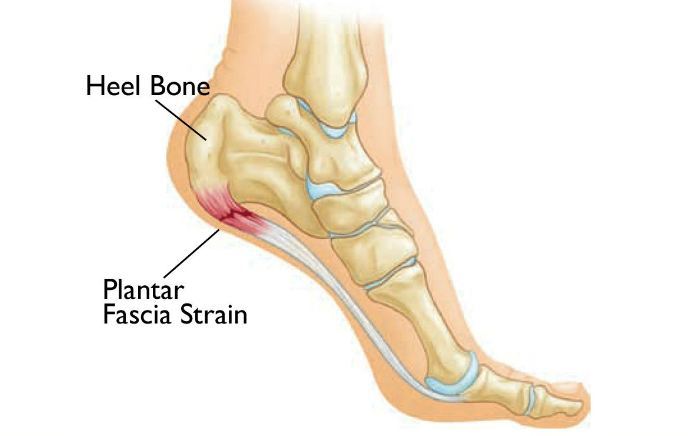What is Heel Spur Syndrome?
HEEL SPUR
A heel spur is a pointed bony outgrowth of the bone of the heel (the calcaneus bone). Chronic local inflammation at the insertion of soft-tissue tendons or plantar fascia is a common cause of bone spurs (osteophytes). Heel spurs can be located at the back of the heel or under the heel, beneath the arch of the foot. Heel spurs at the back of the heel are frequently associated with inflammation of the Achilles tendon (tendinitis) and cause tenderness and heel pain made worse while pushing off the ball of the foot.

What Causes Heel Spur Or Heel Pain?
To understand the cause of the pain, one must understand the anatomy of the foot and some basic mechanics in the function of the foot. A thick ligament, called the plantar fascia, is attached from the bottom of the heel, fanning out into the ball of the foot, and attaching into the base of the toes. The plantar fascia is made of dense, fibrous connective tissue that will stretch very little. It acts as something like a shock absorber. As the foot impacts the ground with each step, the foot flattens out, lengthening the foot. This action pulls on the plantar fascia, which stretches slightly. When the heel comes off the ground, the tension on the ligament is released. Anything that causes the foot to flatten excessively will cause the plantar fascia to stretch greater than it is accustomed to. One consequence is the development of small tears where the ligament attaches into the heel bone. When these small tears occur, a very small amount of bleeding occurs and the tension of the plantar fascia on the heel bone produces a spur on the bottom of the heel. Pain experienced in the bottom of the heel is not produced by the presence of the spur. The pain is due to excessive tension of the plantar fascia as it tears from its attachment into the heel bone. Heel spur formation is secondary to the excessive pull of the plantar fascia where it attaches to the heel bone. Many people have heel spurs at the attachment of the plantar fascia with out having any symptoms or pain. There are some other relatively uncommon causes of heel pain.
There are several factors that cause the foot to flatten and excessively stretch the plantar fascia. The primary factor is the structure of a joint complex below the ankle joint, called the subtalar joint. The movement of this joint complex causes the arch of the foot to flatten and to heighten. Flattening of the arch of the foot is termed pronation and the heightening of the arch is called supination. If there is excessive pronation of the foot during walking and standing, the plantar fascia is strained. Over time, this will cause a weakening of the ligament where it attaches into the heel bone and causes pain. When a person is at rest and off of their feet, the plantar fascia attempts to mend itself. Then with the first few steps, the fascia re-tears causing pain. Generally, after the first few steps, the pain diminishes. This is why the heel pain tends to be worse the first few steps in the morning or after rest.
Another factor that contributes to the flattening of the arch of the foot is the tightness of the calf muscles. The calf muscle attaches into the foot by the Achilles tendon into the back of the heel. When the calf muscle is tight, it limits the movement of the ankle joint. When ankle joint motion is limited by the tightness of the calf muscle, it forces the subtalar joint to pronate excessively. Excessive subtalar joint pronation can cause several different problems to occur in the foot. In this instance, it results in excessive tension of the plantar fascia. The tightness of the calf muscles can be a result of several different factors. Exercise, such as walking or jogging, will cause the calf muscle to tighten. Inactivity or prolonged rest will also cause the calf muscle to tighten. Women who wear high heels and men who wear western style cowboy boots will, over time, develop tightness in the calf muscles.
Heel Spur Diagnosis
The diagnosis of heel pain and heel spurs is made by a thorough history of the course of the condition and by physical exam. Weight-bearing x-rays are useful in determining if a heel spur is present and to rule out rare causes of heel pain such as a stress fracture of the heel bone, the presence of bone tumors or evidence of soft tissue damage caused by certain connective tissue disorders.
Heel Spur Treatment
Treatments for heel spurs may include:
- Rest: Getting plenty of rest and taking pressure off the feet can help to reduce pain and swelling in the affected area.
- Applying ice: This can help reduce pain and swelling.
- Using custom-made orthotics (shoe inserts): These donut-shaped inserts go inside the shoe to take the pressure off the heel.
- Wearing cushioned sports shoes: These may also help to relieve pressure and reduce pain.
- Anti-inflammatory medication: This helps to reduce swelling.
- Cortisone injections: These reduce swelling and pain in the affected area. They are a stronger option if over-the-counter anti-inflammatory medication is not effective.
- In rare cases, surgery may be necessary to remove the heel spur. However, the above treatments are usually effective, and surgery is not needed.
If heel spurs are caused by an inflammatory type of arthritis, treatments for the underlying condition may also improve symptoms.
Our Board Certified Podiatrists
Socal Foot and Ankle doctors are committed to delivering the most exceptional treatments.

Board Certified Foot & Ankle Specialist
Office Time
Location: Santa Monica
Mon – Thur: 9:00 AM – 5:00 PM
Friday: 9:00 AM – 5:00 PM
Location Marina Del Rey
Mon – Thur: 9:00 AM – 5:00 PM
Friday: 9:00 AM – 5:00 PM
Location: Cedars Sinai
Mon – Thur: 9:00 AM – 5:00 PM
Friday: 9:00 AM – 5:00 PM

Board Certified Foot & Ankle Specialist
Office Time
Location: Santa Monica
Mon – Thur: 9:00 AM – 5:00 PM
Friday: 9:00 AM – 5:00 PM

BOARD CERTIFIED
FOOT & ANKLE
Surgeons
- Comprehensive Treatment of Foot & Ankle Conditions in the Pediatric, Adult & Geriatric population
- 3 Practice Locations Santa Monica Medical Plaza, Cedars Sinai Medical Towers, & UCLA Health in Marina Del Rey
- On Staff with Providence Saint Johns Health Center &Cedars Sinai Medical Center
